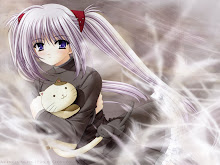J-pop princess, Utada Hikaru has released her new album named "This is the One", and is now available on I tunes. "This Is The One" is No.19 in the store rankings, and is the first album by a japanese singer to break the Top 100 in it's five year history. The new album goes on sale in CD in May. Utada Hikaru is focusing on the U.S. market since, she's already a well- established singer in Japan who has released five albums with profits over 17 million dollars. Fashion
The term "Harajuku” describes teenagers dressed in any fashion style who are in the area of Harajuku. This fashion infuses multiple looks and styles to create a unique form of dress. One of these styles, Kawaii, came to fame in the 1990’s. Kawaii became a popular phrase that meant something was cute or pretty. Kawaii was a form of resistance in that the style and culture associated with it were not seen as attractive by an older generation. This idea of Kawaii was a distinct youth culture separate from the traditional one in existence.
The cyber-punk look takes its influence from gothic fashion and incorporates neon and metallic colors. However, it’s not as popular as it was in the 1990’s. Gothic-Lolita style was created in Osaka. It is a play on Victorian era princess fashions and was merged with gothic fashion. By wearing and promoting these styles performers allowed the fashions to flourish because fans were eager to replicate their idols.
Punk style in Harajuku is more of a fashion than a statement. Its fashion mainly consists of dark colors, plaid, chains, and zippers. Punk style is also one of the more gender-neutral fashions in Harajuku.
Ura-Hara is another section of Harajuku, which caters to a mostly male population interested in a hip-hop, graffiti, and skater fashion and culture. Ura-Hara is seen as the opposite of Harajuku in that it’s more hidden and reserved.
Cosplay is more of a costume-based style. A cosplay enthusiast will usually dress as a fictional or iconic character from a band, movie, or manga.
Japanese Culture in NYC :Special Event: KRAZY!& Cosplay Party
Saturday, March 28, 5:30 PM — 8:30 PM
KRAZY! will be New York’s first major show dedicated to the Japanese phenomenon of Anime, Manga, and Video Games—three forms of contemporary visual art that are exercising a huge influence on an entire generation of American youth. In addition to the exhibition KRAZY! The Delirious World of Anime + Manga + Video Games, Japan Society holds its first-ever Cosplay Party, inviting local fans to create and show off costumes of their favorite characters and share their enthusiasm for anime, manga and video games.
Admission to the Cosplay Party includes:
§ A costume competition with prizes from Kinokuniya Bookstore andManga Entertainment! The KRAZY! Cosplay Contest will be judged by members of World Cosplay Summit Team USA and Ningin.com!
§ Music from DJ VDRK and a special performance from Reni singing songs in Harajuku and Akihabara style!
§ FREE entrance to the KRAZY! exhibition featuring original manga artwork, hundreds of manga to read, an environment by cutting-edge architectural practice Atelier Bow-Wow, and playable video games! Classic anime film clips from Akira, Mind Game, Super Dimension Fortress Macross, Paprika, and more!
§ Costume Contest Prizes:
1st Place: $200 gift certificate to Kinokuniya Bookstore
2nd Place: $100 gift certificate to Kinokuniya Bookstore
3rd Place: $50 gift certificate to Kinokuniya Bookstore
Other prizes: DVDs of Ninja Scroll, Straight Jacket and Ghost in the Shell provided by Manga Entertainment and Street Fighter 4 for PS3
Tickets:
$10 pre-register
$15 at the door
http://www.japansociety.org/event_detail?eid=30d38e21
News from Japan:Tokyo girls prefer school uniform-like dresses
Teenage girls in Tokyo these days see a school uniform not something suggest discipline but something that symbolizes their sensitivity to trends in fashion.
An increasing number of female students in high schools and even some in junior high schools in Tokyo prefer going to school wearing uniform-like clothes even if they have not been told to wear a real uniform.
Yasuko Nakamura, president of Tokyo-based marketing company Boom Planning Co, said the trend is believed to have started around 2002, when she found one high school girl wearing different ‘‘uniforms’’ every time she saw her.
Nakamura later realized that what appeared to be school uniforms were in fact just their favorite dresses.
‘‘The school uniform (for girls) used to be regarded as a symbol of an education with strict regulations. But today, wearing a uniform should be recognized as a privilege only for high school girls,’’ Nakamura said.
Many magazines for young girls feature topics on school uniform-like dress, approvingly called ‘‘nanchatte seifuku’’ (fake uniform), Nakamura said. Against the backdrop of such a trend, a boutique dealing exclusively with school uniform-like apparel opened in Tokyo’s trendy Harajuku district in February 2008.
Shizuka Fujioka is a TV personality who works at the boutique CONOMi. Fujioka is nicknamed the ‘‘charismatic coordinator’’ due to what her fans describe as her good sense in selecting clothes for potential customers.
The shop has seen the number of customers jump four-fold since its opening and is organizing an event called Brand School Uniform Collection 2009 to exhibit and sell uniform-like dresses in Tokyo which will run through April 6.
SAYONARA, till next time...



